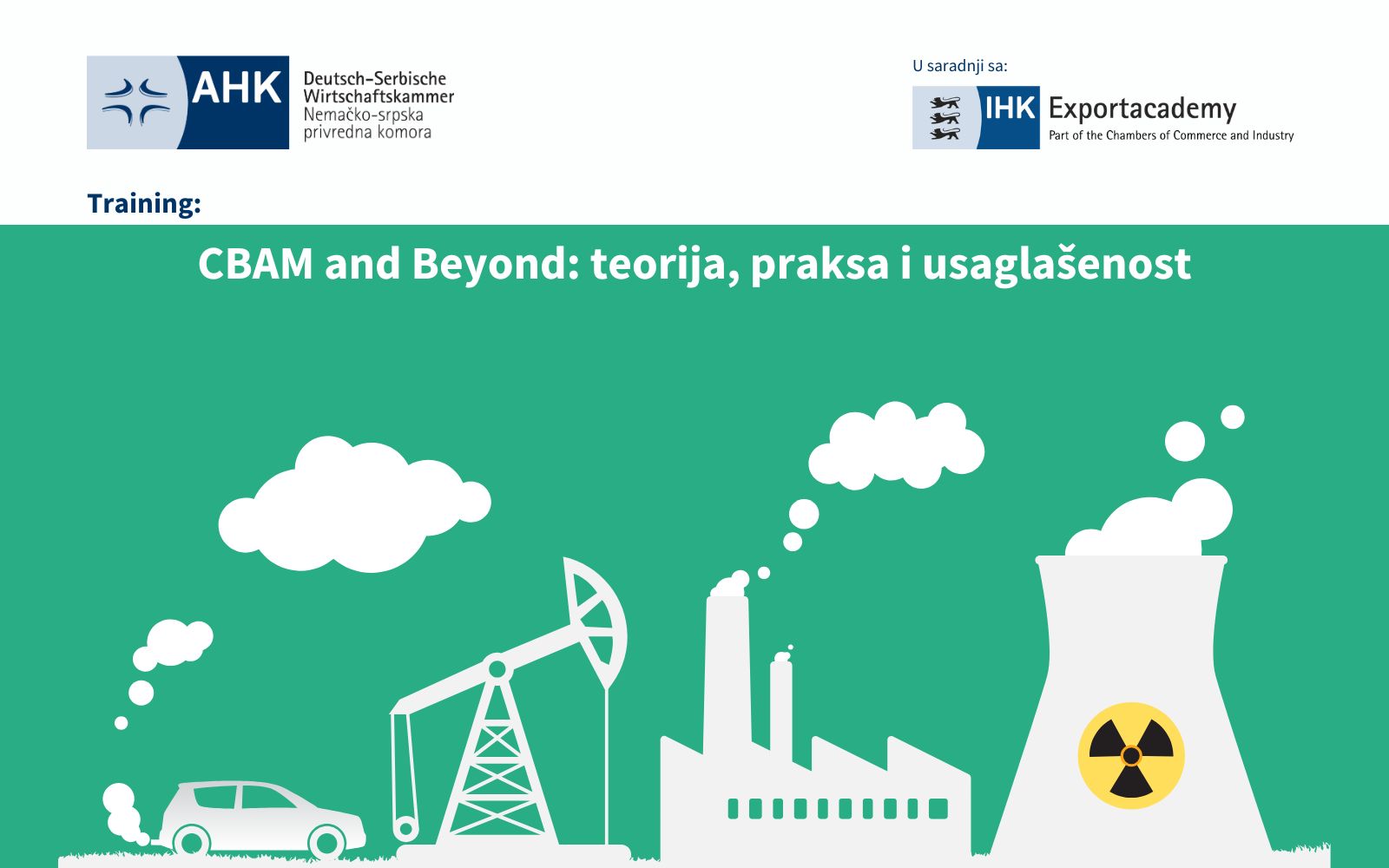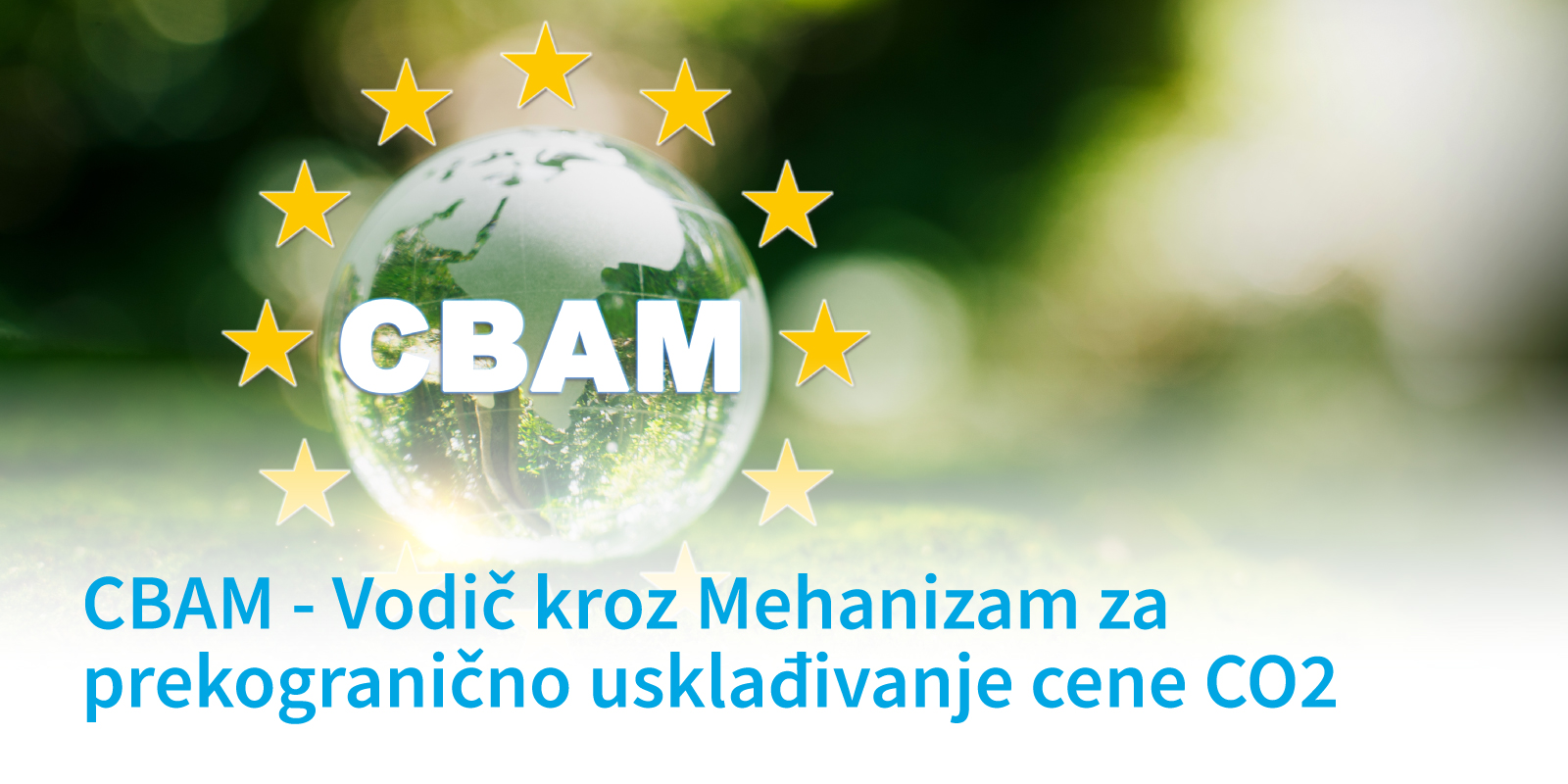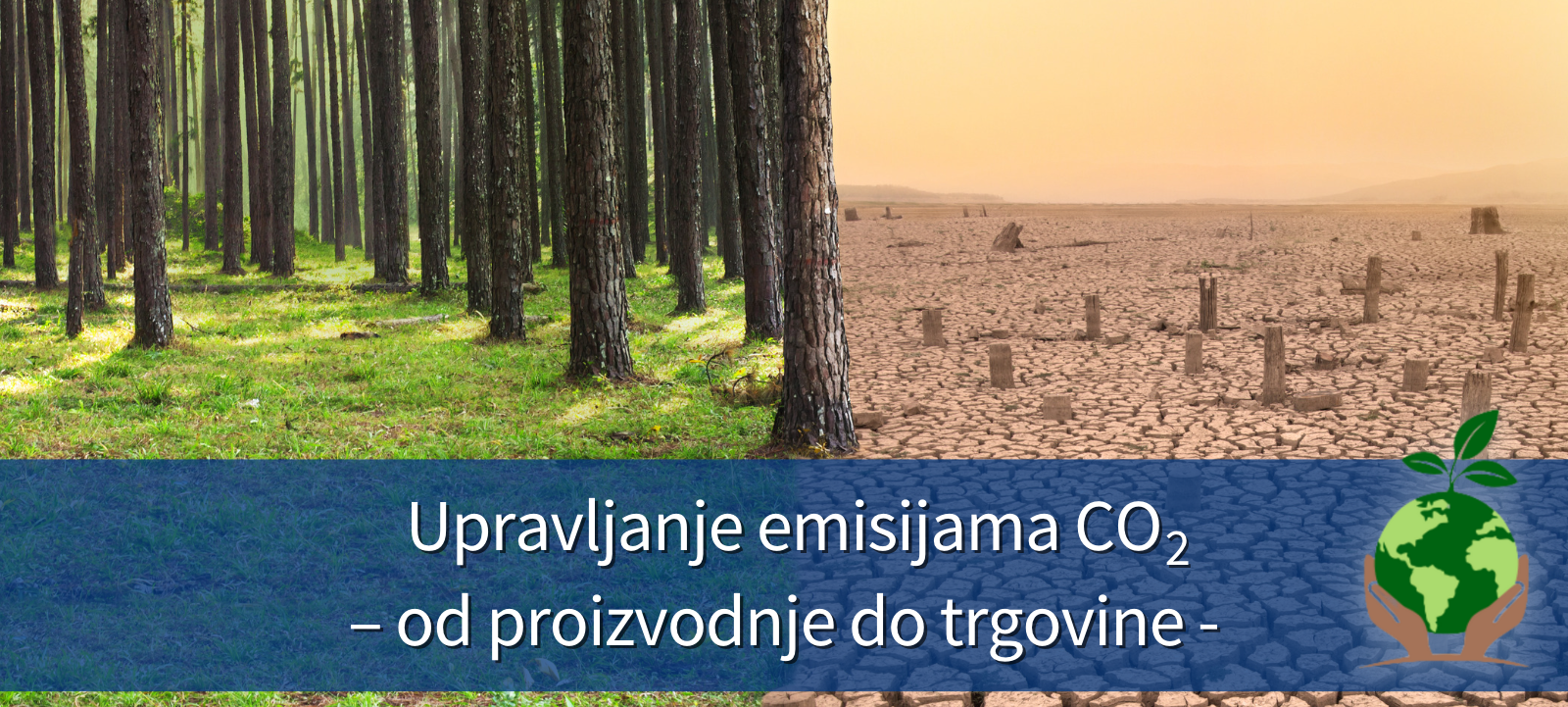CBAM & Beyond: teorija, praksa i usaglašenost

Obuka CBAM & Beyond: teorija, praksa i usaglašenost je kreirana u saradnji sa Exportakademie Stuttgart i pruža svojersni miks lokalne i nemačke ekspertize i stručnosti, uz praktičan rad i primenu.
Polaznici obuke CBAM & Beyond: teorija, praksa i usaglašenost će saznati kako da njihove kompanije odgovore na zahteve nemačkih, ali i EU propisa i zakona kao što su CBAM, nemački Zakon o dužnoj pažnji u dobavljački lancima (LkSG) i EU Direktiva o dubinskoj analizi korporativne održivosti (CSDDD) i kako ti zakoni utiču na poslovanje kompanija u Srbiji, iako Srbija nije članica EU.
Obuka je na srpskom i engleskom jeziku i sastoji se iz teorijskog (video lekcije – snimak hibridne obuke koja je održana 28.11.2024. godine) i praktičnog dela (izrade CBAM izveštaja na osnovu zadatih parametara).
MODULI:
1. Propisi i standardi koji utiču na konkurentnost kompanija iz Srbije na nemačkom i EU tržištu (CBAM, LkSG, CSDDD), Jasmina Trbović, projektna menadžerka, Nemačko-srpska privredna komora
2. CBAM – German Perspective, Dr Hartmut Henninger, pravnik, Graf von Westphalen (Exportakademie Stuttgart)
3. CBAM izveštavanje – metodologija, monitoring emisija, kreiranje izveštaja, naučene lekcije, saveti, Dr Lazar Kaluđerović, konsultant za monitoring GHG emisija
PRAKTIČNI RAD: CBAM izveštaj – na osnovu instrukcija, polaznici samostalno izrađuju CBAM izveštaj koji zatim dostavljaju.
SERTIFIKAT
Kreiranje digitalnog Sertifikata o završenoj obuci će biti omogućeno polaznicima koji:
- uspešno urade praktični rad
- uspešno urade završni test na platformi za e-učenje
Obuka je namenjena menadžerima i specijalistima za ESG i održivost, ekspertima koji se bave unapređenjem procesa, specijalistima strateške nabavke, zaposlenima koji rade u proizvodnim kompanijama, izvoznicima robe i sirovina u EU, dobavljačima sirovina i zaposlenima u špediterskim kompanijama, kao i svima koji žele više da saznaju o ovoj aktuelnoj temi.
Cena obuke iznosi 220 EUR (+PDV)
*Kompanije članovi Nemačko-srpske privredne komore ostvaruju popust, te cena za njih iznosi 187 EUR (+PDV)Faktura se izdaje u dinarskoj protivvrednosti po srednjem kursu NBS na dan izdavanja fakture.
Obuka je dostupna u periodu od 90 dana od datuma uplate. Praktični rad treba predati najkasnije 7 dana pre isteka dostupnosti obuke.
Za sva pitanja možete kontaktirati Jasminu Trbović na trbovic@ahk.rs
Upravljanje emisijama CO2 – od proizvodnje do trgovine
Decenijama se vode diskusije o klimatskim promenama i njihovim posledicama. Međutim, usled urgentne potrebe da se zaustavi globalno zagrevanje, ovo pitanje danas ima još veći značaj, ne samo među državama, već i među kompanijama širom sveta.
Važne međunarodne akcija kao što su Pariski sporazum (Paris Agreement, 2015) i Evropski zeleni dogovor (European Grean Deal, 2019), predstavljaju odgovor na efekte izazvane emisijama ugljen-dioksida (CO2) u Zemljinu atmosferu i sadrže ambiciozne ciljeve za neutralizaciju. Kao posledica toga, države - posebno članice Evropske unije, moraju da usvoje strože zakone i propise koji direktno utiču na poslovanje kompanija i njihovih dobavljača. Isto se odnosi i na one koje nisu iz Evrope. Ceo lanac snabdevanja primoran je da se prilagodi novim klimatskim ciljevima. Potrebno da se unapredi i proširi znanje o upravljanju ugljen-dioksidom, kako kod velikih kompanija, tako i kod malih i srednjih preduzeća. Prilagođavanje za mala i srednja preduzeća može da bude izazovnije, te je potreba za unapređenjem ličnih kvalifikacija još hitnija.
Imajući ovakvu situaciju u vidu, Nemačko-srpska privredna komora, u saradnji sa Nemačko-brazilskom privredna komorom u Sao Paolu i Nemačko-ukrajinskom komorom u Kijevu, a u partnerstvu sa nemačkom Organizacijom za međunarodnu saradnju (GIZ), pruža onlajn obuku za rukovodioce i stručnjake u kompanijama svih veličina i sektora, sa fokusom na praktična znanja. Cilj ove obuke je da polaznicima pruži osnovne kvalifikacije po pitanju upravljanja emisijama CO2. Očekuje se da će polaznici steći znanja i moći da ih praktično primene u svojim kompanijama, kao i da će promovisati samu temu kroz konkretne rezultate.
- Omogućiti stručnjacima iz kompanija svih veličina i sektora da razviju inicijative za upravljanje emisijama CO2, interno i/ili u mreži.
- Stručnjaci čije poslovne aktivnosti obuhvataju ciljeve održivosti, lanac snabdevanja i propise, od tehničara i analitičara do rukovodilaca.
- Kompanije koje treba da obuče svoje zaposlene u domenu upravljanja emisijama CO2, sa ciljem da se prilagode novim propisima i zahtevima zaštite životne sredine.
- Okvirno 40 sati sadržaja
- Video nastava;
- E-knjige i prateći materijali;
- Vebinari – praktične studije slučaja;
- Reference za video zapise i članke;
- Test znanja.
- 4 - Kvalitetno obrazovanje
- 9 - Industrija, inovacije i infrastruktura
- 11 - Održivi gradovi i zajednice
- 12 - Odgovorna potrošnja i proizvodnja
- 13 - Akcija za klimu
- 17 - Partnerstvom do ciljeva
Sadržaj:
(za prikaz i sakrivanje sadržaja, kliknite na naziv modula ili na strelicu ispred naziva)
Pored upoznavanja sa pojmom emisije CO2, glavnim izvorima emisije po privrednim sektorima kao i procesima koji najviše emituju, osnovni cilj ovog modula je da objasni načine i sredstva za merenje i izveštavanje o emisijama CO2.
Biće predstavljeni načini upravljanja kako bi svaka kompanija, u skladu sa svojim mogućnostima i potrebama, mogla da izabere onaj koji će biti efikasan, održiv i integrisan u oblast njene delatnosti i njen poslovni plan. Zatim će biti predstavljeni osnovni koncepti upravljanja emisijama CO2 (ublažavanje, smanjenje i neutralizacija), kao i glavni načini i alati za njihovo sprovođenje i konačno i njihovo kompenzovanje.
Cilj ovog modula je pružanje podrške kompanijama kako bi na efikasan način, kroz primenu najadekvatnijih internih procedura za upravljanje emisijama, mogle da analiziraju emisije svojih proizvoda - od njihove proizvodnje do odlaganja ili ponovne upotrebe.
Kroz specifične procedure i alate, biće objašnjen ugljenični otisak, odnosno proces analize emisija tokom celog veka trajanja proizvoda i proizvodnje u celini. „5R“ održivosti (eng. Reduce, Reuse, Refuse, Recycle and Rethink) je istovremeno i efikasna i relevantna metoda za upravljanje emisijama i promenu obrazaca potrošnje. Iz tog razloga će njena primena u kontekstu biti objašnjena zajedno sa ostalim alatima upravljanja.
Predmet četvrtog modula su sertifikati o emisijama iz domaće proizvodnje i o emitovanim ugljeničnim kreditima. Ovaj deo predstaviće njihove glavne vrste, osnovne pretpostavke i ciljeve kako bi kompanije imale u vidu mogućnosti i važnost sertifikacije ugljenika i kako bi mogle doneti informisanu odluku o tome hoće li ih uključiti u svoju strategiju ili ne.
Ovaj modul pružiće objašnjenje o tome koji sertifikati postoje, kom alatu za upravljanje emisijama CO2 odgovara svaki sertifikat, o procedurama neophodnim za njihovo dobijanje, ali i o tome kako brendovi mogu imati koristi od sertifikovanja svojih alata za upravljanje emisijama CO2.
Cilj modula je da kompanije razumeju koncepte i različite vrste određivanja cena, uključujući i razloge za obračun i kako da interno uspostave politiku određivanja cena ukoliko je ovaj instrument u skladu sa sistemom menadžmenta.
Kroz modul će se objasniti istorija određivanja cena, koncept i njegova praktična primena, u unutrašnjem i spoljnom okruženju, razlozi koji stoje iza određivanja cena i načini za njihovo formiranje i izračunavanje, uključujući i koje varijante i ciljeve treba uzeti u obzir pri određivanju. Modul će se baviti i uspostavljanjem cena ugljenika u unutrašnjem okruženju kompanija; vrstama cena (obračunske cene/cene u senci ili tržišne cene); praksom; načinima na osnovu kojih uspostavljanje cena treba sprovesti i razlozima koji motivišu primenu.
Na početku modula biće naglašen značaj inventara emisija i predstavljen korak mapiranja i analize rizika i prilika u unutrašnjem i spoljnom okruženju, što je neophodno pre efektivnog usvajanja korporativne strategije. U nastavku će biti nabrojane pretpostavke za uspešnu strategiju, kroz koju se postiže odnos između klimatskih akcija i održivog rasta, kao i strategije za prilagođavanje klimatskim promenama, uz pojašnjenje prednosti integrisanja korporativnog ugljeničnog otiska u različite faze strateškog planiranja.
Modul će ukazati na načine izračunavanja i dokazivanja koristi od ulaganja i preduzetih radnji, kao što su povrat investicije, specifičan povrat za održivost, ciljeve i pokazatelje primene mera upravljanja ugljenikom u kompanijama. Pored toga, ovaj deo će naglasiti odgovarajući način za predstavljanja rezultata u izveštajima o održivosti i značaj uključivanja zainteresovanih i trećih strana u mreže delovanja.
Osmi modul baviće se pitanjem finansiranja projekata održivosti sa fokusom na životnu sredinu.
Kao i kod drugih vrsta projekata, projekti upravljanja ugljenikom takođe zavise od finansiranja koje treba spovesti. U ovom slučaju, očekivani povrat nije uvek finansijski, iako često završi kao sekundarni povrat, već je fokus uglavnom na povratu koji se odnosi na ciljeve održivosti, kao što su smanjenje i kompenzacija.
Kako bi se razjasnilo da li je ulaganje i/ili stvaranje investicionih fondova za projekte ekološke održivosti moguće i u skladu sa planovima kompanije, ovaj modul će detaljnije objasniti koncept i logiku iza svakog od njih. Dodatno će se pojasniti koje su prednosti ulaganja za investitore i povrat.
Cilj ovog modula je da obezbedi bazu znanja za primenu praksi u kompanijama koje podržavaju integrisanu strategiju korporativnog upravljanja i održivosti, a koja je pretežno fokusirana na upravljanje ugljenikom.
Na kraju ovog modula biće predstavljene inovacije i tehnologije koje su primenjene na upravljanje ugljenikom i tržište, zajedno sa već razvijenim ili tehnologijama u razvoju koje će transformisati ovu oblast.
Cilj modula je da uključi mala i srednja preduzeća u održive prakse zbog obima njihovog poslovanja, novih standarda snabdevanja i porekla koji se zahtevaju od dobavljača, kao i tendencije da se obuhvate svi aspekti lanca vrednosti u upravljanju i izveštavanju o emisijama.
Prvo će biti predstavljene osnove i polazne tačke koje mala i srednja preduzeća treba da preduzmu u procesu upravljanja ugljenikom. Odgovornost koja se proteže kroz ceo lanac biće ilustrovana objašnjenjem nemačkog Zakona o dužnoj pažnji.
Nakon toga, sledi stručno predstavljanje globalnih i lokalnih uspešnih slučajeva malih i srednjih preduzeća koja su integrisala upravljanje ugljenikom u svoje poslovanje i obrazloženje njihove konkurentske razlike. Na kraju, opisan je kratak osnovni priručnik za uspešno usvajanje procesa i alata za upravljanje ugljenikom za mala i srednja preduzeća.
Pilot grupa čiji su članovi bili
zaposleni u kompanijama koje su članice Nemačko-srpske privredne komore je u
sklopu obuke sprovela i praktičnu aktivnost u svom lokalnom kontekstu - Sagledavanje
direktnih i indirektnih (Scope 1, Scope 2 i Scope 3) emisija u kompaniji “XXX”.
U video lekciji ćete na primerima iz realnog poslovnog okruženja videti kako kompanije iz različitih, ne samo proizvodnih, već i servisnih delatnosti sagledavaju emisije CO2 i kako se, u zavisnosti od delatnosti, razlikuju vrste emisija.
Mentorsku podršku pilot grupi pri samoj izradi i prezentovanju radova pružila je Služba za energetsku efikasnost i zaštitu životne sredine ProCredit banke.
Carbon Management Base Content

Climate change and its effects have been debated for decades. However, due to the urgency of stopping global warming, this matter is gaining even more importance among nations and companies around the world.
Important international actions such as the Paris Agreement (2015) and the European Green Deal (2019) represent a response to the impacts caused by the emission of carbon dioxide (CO2) into the Earth's atmosphere and contain ambitious goals for its neutralization. As a consequence of these goals, countries, especially members of the European Union, have to adopt stricter laws and regulations that directly affect the operations of companies and their suppliers. The same applies to non-European ones. The entire supply chain is compelled to adapt to the new climate objectives. There is a need to generate and disseminate knowledge on carbon management, both in large companies and SMEs. Adaptation for SMEs may be more challenging as the need to upgrade personal qualifications is even more urgent.
In this scenario, the German-Serbian Chamber of Commerce, in cooperation with the German-Brazilian Chamber of Commerce in Sao Paulo and the German-Ukrainian Chamber of Commerce in Kyiv, and in partnership with the German Agency for International Cooperation (GIZ), offers an online practice-oriented training course for managers in companies of all sizes and sectors. The objective of this course is to provide participants with basic qualifications in CO2 emission management. It is expected that they will be able to build up a know-how in their own companies, as well as to promote the application of the topic through concrete results.
- Enable professionals from companies of all sizes and sectors to develop carbon management initiatives – internally and/or in a network.
- Professionals with activities involving sustainability goals, supply chain, regulations, etc. From technicians and analysts to executives.
- Companies that need to train their employees regarding carbon dioxide emissions management, aiming to adapt itself to the new regulations and environmental demands.
- About 40 hours of content
- Video classes;
- E-books and support material;
- Webinars – Practical Case Studies;
- Video and article references;
- Knowledge test.
- 4 - Quality Education
- 9 - Industry, Innovation, and Infrastructure
- 11 - Sustainable Cities and Communities
- 12 - Responsible Consumption and Production
- 13 - Climate Action
- 17 – Partnerships for the Goals
Content:
(to show and hide content, click on the module name or on the arrow in front of the name)
Concept of carbon emissions, the main sources of emissions by economic sector, and the processes that most emit will be introduced. We will discuss what the greenhouse gas emission inventory protocols are, how they work, their scope, importance and what they represent at the national and international level. The main objective of this module is to explain the ways and means of measuring and reporting CO2 emissions. Next, we will present management methods, so that each company can choose, according to its capabilities and needs, the one that will be efficient, sustainable and integrated into the company's field of activity and business plan.
This module provides an explanation of the basic concepts for carbon management, namely mitigation, reduction and neutralization. Along with these concepts, the main methods and tools for their implementation will be presented. The last sub-topic relates to carbon offseting.
The objective of this module is to help institutions analyze their emissions from production to disposal or reuse of their products, in an efficient way and with the application of the most appropriate internal emission management procedures.
Through specific procedures and tools, the process of analyzing emissions during the entire life cycle of a product and production as a whole will be explained, i.e. the carbon footprint in economic sectors. The "Five R's" of sustainability (Reduce, Reuse, Refuse, Recycle and Rethink) in addition to re-inclusion in the value chain are presented as a traditional way of thinking. This method is both effective and relevant for managing emissions and changing consumption patterns. Therefore, their application in context will be explained together with other management tools.
Environmental and sustainability certificates are necessary to prevent fraud or exaggeration of environmental actions by companies. This can happen through the creation of only positive publicity, without real engagement of the brand. The subject of the fourth module are certifications on emissions from domestic production and on emitted carbon credits. This section will present their main types, basic assumptions and objectives so that companies can consider the possibilities and importance of carbon certification and make an informed decision about whether or not to include them in their strategy.
We will discuss the main certifications that exist in Brazil and globally as well as which carbon management tool each certification corresponds to (mitigation, reduction, neutralization or compensation). We will also explain the necessary procedures for obtaining them. This module will provide an explanation of how brands can benefit from certifying their carbon management tools, thereby adding value to their products and services and retaining conscious customers.
The objective of the module is for companies to understand the concepts and different types of pricing, the rationale behind the calculation, and how to internally establish a pricing policy if this instrument is in line with management.
The module will explain the history of pricing, the concept and its practical application in Brazil and in the world, in the internal and external environment. In addition, issues that will be addressed in this module include the rationale behind pricing, how prices are determined and calculated, and what options and objectives should be considered when setting prices. Finally, the module will address the establishment of carbon pricing in the internal environment of companies, the types (shadow or effective pricing), practice, ways of functioning and reasons that motivate the implementation.
First, the importance of emissions inventory will be emphasized and the step of mapping and analyzing risks and opportunities in the internal and external environment will be presented. This step is necessary before the effective adoption of the corporate strategy. Subsequently, the prerequisites for a successful strategy will be listed, through which the relation between climate action and sustainable growth is achieved.
Strategies for adapting to climate change, such as risk mitigation and development of competitive advantages, will be outlined and explained along with the benefits of integrating the corporate carbon footprint into the various stages of strategic planning. This can benefit companies in terms of image and profits, as well as facilitate adaptation to future and international laws, in case of expansion.
The module will indicate ways to calculate and prove the benefits of investments made and actions taken, such as return on investment (ROI), a specific ROI for sustainability, targets and indicators for the implementation of carbon management measures in companies. Also, the module will highlight appropriate ways to present results in sustainability reports and the importance of engaging stakeholders and third parties in action networks.
As with other types of projects, carbon management projects are also dependent on funding. Accordingly, such investment should bring tangible returns to organizations and individual investors. In this case, the expected return is not always financial, although most of the time it ends up as a secondary return. The focus is usually on returns related to sustainability goals, such as reduction and offsetting.
Green or climate bonds are investment bonds used to finance sustainability projects focused on climate change in a wide variety of areas, such as infrastructure, emissions reduction or research and innovation. ESG funds are investments in assets intended to finance sustainable initiatives in all areas, including social impact. The eighth module will address the issue of financing sustainability projects with a focus on the environment.
To clarify whether the investment and/or creation of investment funds for environmental sustainability projects is possible and in line with the company's plans, this module will explain in more detail the concept and logic behind each of them. It will further explain the benefits for investors and return.
The objective of this module is to provide a knowledge base for the application of practices in companies that support an integrated strategy of corporate governance and sustainability, which is mainly focused on carbon management. It is important to clarify that in most cases best practices are researched and developed through networked initiatives.
At the end of this module, innovations and disruptive technologies applied to carbon management and market, along with technologies already developed or in development that tent to transform this area. We will also present newly developed solutions that can be applied internally or as a part of companies’ partnership network.
Small and Medium-sized companies, also known by the acronym SMEs, represent the largest share of the world economy and are a fundamental part of large B2B or B2C value chains. The objective of the module is to engage these companies in sustainable practices due to the scale of their operations, the new supply and origin standards required of suppliers, and the tendency to cover all aspects of the value chain in emissions management and reporting.
First, the basics and starting points that small and medium enterprises should take in the process of carbon management will be presented. This module will emphasize the important relationship of these companies with value chains. Chain-wide responsibility will be demonstrated through an explanation of the German Due Diligence Act, the predecessor of the binding measure for the integrity of the entire chain.
This is followed by a presentation of global and Brazilian successful cases of small and medium-sized enterprises that have integrated carbon management into their operations and the explanation of their competitive difference. Finally, a short basic manual for the successful adoption of carbon management processes and tools for SMEs is described.
As part of the training course, the pilot group, whose members were employees of companies that are members of the German-Serbian Chamber of Commerce, conducted a practical activity in their local context - Review of direct and indirect (Scope 1, Scope 2 and Scope 3) emissions in the company "XXX" .
In the video lesson, you will see examples from a real business environment, how companies from different, not only production but also service activities look at CO2 emissions, and how, depending on the activity, the types of emissions differ.
The Environmental Unit of ProCredit Bank provided mentoring support to the pilot group during the preparation and presentation of the works.
CBAM - Vodič kroz Mehanizam za prekogranično usklađivanje cene CO2

CBAM - Vodič kroz Mehanizam za prekogranično usklađivanje cene CO2
Evropska unija je kao jedan od svojih dugoročnih ciljeva postavila borbu protiv klimatskih promena i definisala ambiciozne planove za smanjenje emisija gasova staklene bašte. Jedan od ključnih instrumenata u postizanju ovih ciljeva je i CBAM (Carbon Border Adjustment Mechanism), koji je kao regulacioni mehanizam stupio na snagu 1. oktobra 2023. godine.
On predstavlja svojevrsnu vrstu „CO2 takse“ na proizvode koji se uvoze u EU iz zemalja koje nemaju tako rigorozne ekološke standarde kao EU.
CBAM - Mehanizam za prekogranično usklađivanje cene CO2 dobija sve više na važnosti, kako se bliže novi rokovi za slanje izveštaja i novi ključni datumi u faznoj primeni ovog alata kojim EU sprečava „curenje“ emisija CO2.
Online on-demand obuka na našoj AHK Green Academy Serbia daje odgovore na brojna pitanja od kojih su najčešća:
- Koliko je CBAM usklađen sa zakonodavnim okvirom u Srbiji?
- Koji su ključni datumi i šta oni donose privrednim subjektima u Srbiji?
- Kako se izračunavaju emisije CO2 za proizvod koji se izvozi u EU?
- Kako se popunjava i kome se podnosi CBAM izveštaj?
- Koja je uloga obnovljivih izvora energije i kako utiču na CBAM izveštaj?
- Kako zaštiti poverljivost poslovnih podataka prilikom podnošenja CBAM izveštaja?
CBAM - Vodič kroz Mehanizam za prekogranično usklađivanje cene CO2 polaznicima daje mogućnost da, razumevajući zahteve koje EU zakonodavstvo postavlja pred kompanije u Srbiji i unapređujući svoje procese i strategije, očuvaju konkuretnost svojih izvoznih proizvoda i obezbede održivost svog poslovanja.
Ciljne grupe:
- Menadžeri i specijalisti za ESG i održivost, eksperti koji se bave unapređenjem procesa, specijalisti strateške nabavke, svi koji rade u proizvodnim kompanijama, izvoznici robe i sirovina u EU, dobavljači sirovina i zaposleni u špediterskim kompanijama
- 14 hours
- Uvod u kurs
Šta je CBAM?
- Uvod
- Propuštanje ugljen dioksida (CO2)
- Usklađenost CBAM i ETS
- Ključne karakteristike CBAM
Dinamika uvođenja CBAM-a
- Uvod
- Ključni datumi i obaveze u narednom periodu
- Očekivane prepreke i opterećenja
Kako izgleda CBAM proces?
- Struktura procesa
- Primeri primene CBAM mehanizma
- Uvod
- Šta je do sada urađeno
- Primeri sličnih mehanizama evropskih zemalja van EU
- Sledeći koraci i prepreke
- Usklađenost CBAM sa međunarodnim trgovinskim pravom
- Uvod
- Emisije GHG – osnovna terminologija
- Metodologija obračunavanja
- Uvod
- Potencijal obnovljivih izvora energije – zelena ponuda
- Potencijal potrošača – zelena potražnja
- SWOT analiza primene CBAM-a u Srbiji
- Zaključak
Na kraju svakog modula nalaze se interaktivne vežbe koje ne utiču na ukupnu ocenu na kursu – služe samo za proveru ličnog znanja. Kvalifikacioni test za sertifikat i uspešan završetak kursa nalazi se na kraju, u poslednjem modulu.
- E-knjige i prateći materijali;
- Istraživanja i praktične studije slučaja;
- Reference za članke i istraživanja;
- Test znanja.
- 4 – Kvalitetno obrazovanje
- 5 – Rodna ravnopravnost
- 7 – Pristupačna i čista energija
- 12 – Odgovorna potrošnja i proizvodnja
- 13 – Klimatska akcija
- 17 – Partnerstvo za ciljeve

